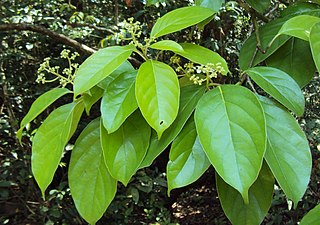Alangium longiflorum is a tree in the dogwood family Cornaceae. The specific epithet longiflorum is from the Latin meaning "long flowers".

Mastixia is a genus of about 19 species of resinous evergreen trees, usually placed in the family Cornaceae. Its range extends from India through Southeast Asia and New Guinea to the Solomon Islands. Mastixia species have alternate or opposite simple broad leaves, many-flowered inflorescences, and blue to purple drupaceous fruits.
Mastixia glauca is a tree in the family Nyssaceae. The specific epithet glauca is from the Greek meaning "bluish-grey", referring to the colour of the leaf underside.
Mastixia macrocarpa is a tree in the family Nyssaceae. The specific epithet macrocarpa is from the Greek meaning "large fruit".
Chisocheton cumingianus subsp. kinabaluensis is a subspecies of Chisocheton cumingianus. It is a tree in the Meliaceae family. It grows up to 37 metres (120 ft) tall with a trunk diameter of up to 50 centimetres (20 in). The bark is grey-brown. The flowers are pale yellow to white. The fruits are round to pyriform, orange-red, up to 7 cm (3 in) in diameter. The tree is named for Mount Kinabalu in Malaysia's Sabah state. Its habitat is rain forests. C. cumingianus subsp. kinabaluensis is endemic to Borneo and known only from Sabah.
Canarium megalanthum is a tree in the family Burseraceae. The specific epithet megalanthum is from the Greek meaning "large flower".
Canarium pilosum subsp. borneensis is a subspecies of Canarium pilosum. It is a tree in the family Burseraceae. The subspecies is named for Borneo.

Dacryodes rostrata is a tree in the family Burseraceae. The specific epithet rostrata is from the Latin meaning "beaked", referring to the narrow-tipped leaves.
Parinari elmeri is a tree in the family Chrysobalanaceae. It is named for the American botanist Adolph Elmer.
Clethra canescens var. clementis is a tree in the family Clethraceae.
Clethra pachyphylla is a tree in the family Clethraceae. The specific epithet pachyphylla is from the Greek meaning "thick leaves".
Connarus agamae is a tree in the family Connaraceae. It is named for José Agama, a former Deputy Conservator of Forests in British North Borneo.
Mastixia cuspidata is a tree in the family Nyssaceae. The specific epithet cuspidata is from the Latin meaning "sharp-pointed", referring to the leaf apex.
Mastixia eugenioides is a tree in the family Nyssaceae. The specific epithet eugenioides is from the Latin and refers to the resemblance of the leaves to those of the genus Eugenia.
Mastixia pentandra subsp. scortechinii is a subspecies of Mastixia pentandra. It is a tree in the family Nyssaceae. It is named for the botanist Benedetto Scortechini.
Mastixia trichotoma is a tree in the family Nyssaceae. The specific epithet trichotoma is from the Greek meaning "three parts", referring to the three-branched inflorescence.
Perrottetia alpestris subsp. philippinensis is a subspecies of Perrottetia alpestris. It is a plant in the family Dipentodontaceae, sometimes classified in the family Celastraceae.
Melicope confusa is a tree in the family Rutaceae.

Melicope triphylla is a plant in the family Rutaceae. The specific epithet triphylla is from the Greek meaning "three leaf", referring to the trifoliolate leaves.
Glycosmis macrantha is a tree of Borneo in the family Rutaceae. The specific epithet macrantha is from the Greek meaning "large flower".


